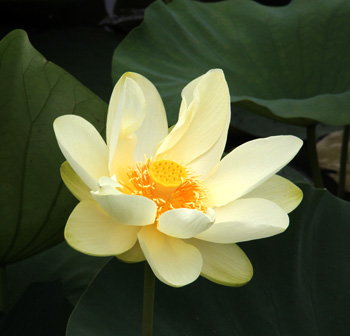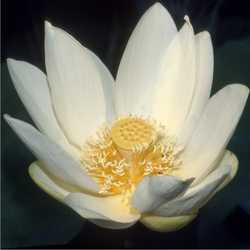Nelumbo lutea, or the American lotus is considered a lovely ornamental in today's world, however, it was an essential staple in the diets of many Native Americans. These spectacular water plants produce large flowers in many of our ponds and lakes, often forming vast colonies. They are hardy in many growing zones and native to North America east of the Rockies from Canada to Florida.
The American lotus is happiest in quiet waters, at the edges of lakes and in coves of slow moving streams. The creamy flowers are often 10 inches or more across and the leaves can reach a couple of feet in diameter. Blooms appear in mid to late summer and the show lasts for several weeks, although each individual blossom only lives for 2 days. The unique seed pods are often harvested after the flowers have faded and used in floral arrangements.
 Native peoples depended on this plant for a large part of their diets. All parts of the plant are edible, from the young leaves and shoots, to the acorn-like seeds produced in the unique shower-head shaped center. However, it was the large fleshy root or tuber that they used most frequently. It was used much like a potato in soups and stews and provided much needed starchy carbohydrate fuel for their diets. The seeds were ground into flour or roasted and the leaves were wrapped around foods for baking. The green seeds were boiled like peas and the mature seeds contained enough natural oil that they could even be popped. This is the most nutritious part of the plant with the seeds containing up to 19% protein. There are many common names that indicate that this plant was used for food by many people. Alligator Corn, Duck Acorns, Water Chinquapin and Pond Nuts are just a few of its more colorful handles.
Native peoples depended on this plant for a large part of their diets. All parts of the plant are edible, from the young leaves and shoots, to the acorn-like seeds produced in the unique shower-head shaped center. However, it was the large fleshy root or tuber that they used most frequently. It was used much like a potato in soups and stews and provided much needed starchy carbohydrate fuel for their diets. The seeds were ground into flour or roasted and the leaves were wrapped around foods for baking. The green seeds were boiled like peas and the mature seeds contained enough natural oil that they could even be popped. This is the most nutritious part of the plant with the seeds containing up to 19% protein. There are many common names that indicate that this plant was used for food by many people. Alligator Corn, Duck Acorns, Water Chinquapin and Pond Nuts are just a few of its more colorful handles.
 The substantial root does not contain a significant amount of vitamins or nutrients, however since many are over a foot long and several inches thick, they are a substantial carbohydrate source. Native Americans even cultivated them in community lakes or ponds and introduced the colonial settlers to the food. The roots are best baked much like a sweet potato with the resulting taste being very similar.
The substantial root does not contain a significant amount of vitamins or nutrients, however since many are over a foot long and several inches thick, they are a substantial carbohydrate source. Native Americans even cultivated them in community lakes or ponds and introduced the colonial settlers to the food. The roots are best baked much like a sweet potato with the resulting taste being very similar.
The American lotus has an Asian cousin, the Sacred Lotus (Nelumbo nucifera) that has been popular in gardens and legends for hundreds of years. Unlike it's western counterpart's yellow-tinted flowers, its flowers are pink. The roots are also edible and are often found in Asian markets and grocery stores.
As beautiful and useful as this plant is, it can become quite invasive where conditions are good. The plants can clog waterways and impede boat traffic, along with choking out other plants.  If you plant it in your own water garden or pond, be aware that they will need thinning to reduce their footprint every few years. Our local bank has a decorative pond in front of their offices that started out with a lovely corner sprinkled with lotus blossoms. This has turned into a wall-to-wall lotus carpet. They choke the pond from bank to bank and their pet ducks have given up trying to swim through the thicket, preferring the nearby road ditch. Whoever is in charge of the grounds needs to thin this growth by at least three quarters. Gardeners, be aware that this plant does need vigilance to keep its spread in check.
If you plant it in your own water garden or pond, be aware that they will need thinning to reduce their footprint every few years. Our local bank has a decorative pond in front of their offices that started out with a lovely corner sprinkled with lotus blossoms. This has turned into a wall-to-wall lotus carpet. They choke the pond from bank to bank and their pet ducks have given up trying to swim through the thicket, preferring the nearby road ditch. Whoever is in charge of the grounds needs to thin this growth by at least three quarters. Gardeners, be aware that this plant does need vigilance to keep its spread in check.
There are a number of commercial sources, but if you know someone who grows the American lotus, chances are they would be more than happy to share a root or two. It is a tough and hardy native plant and makes a grand statement in the water garden.
The image of the lotus roots is courtesy of Wikimedia Commons, the rest belong to me.


















